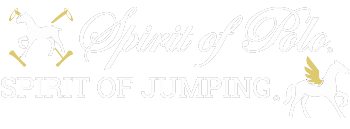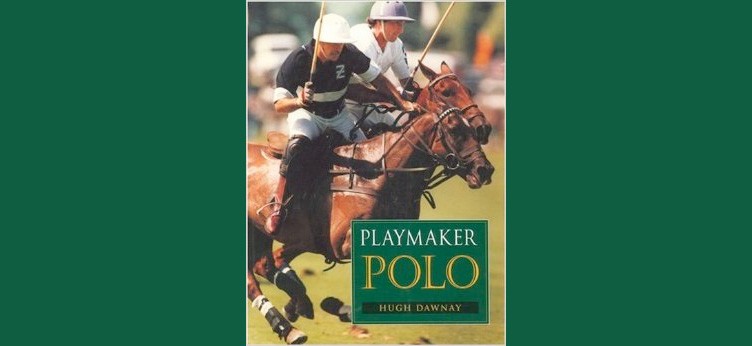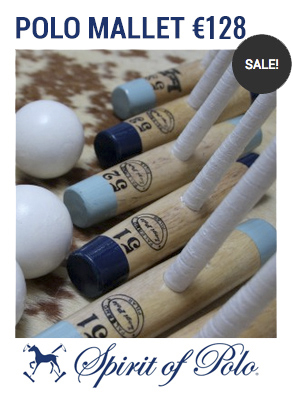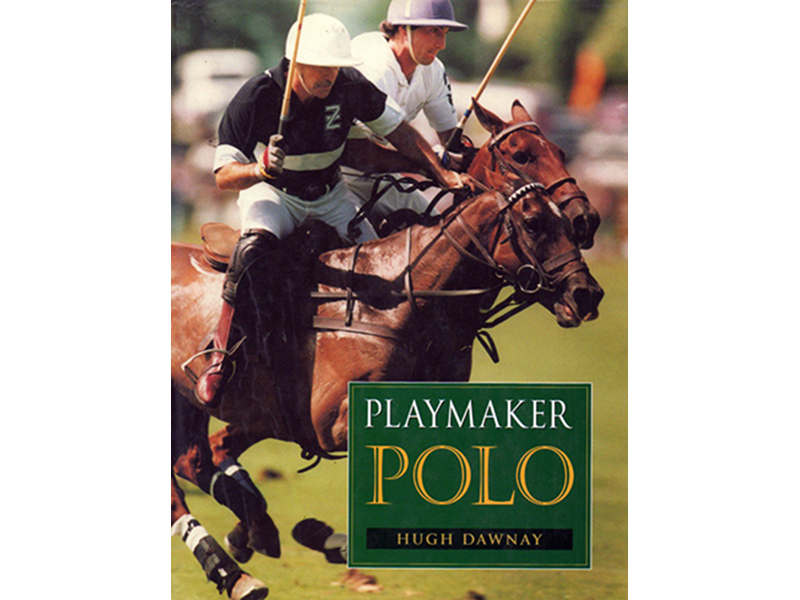
2) RIDING
Make the pony follow you, by looking in new direction, before and during execution of turns.

4) STRIKING THE BALL
Keep your polo mallet vertically up and weightless, before each shot, unless it is a half shot.

5) RIDING
Always squeeze the pony with your legs to initiate slowing, accelerating, turning and striking the ball.

6) TACTICAL THINKING
Continually watch your team’s best player to whom you must relate your position in attack and defenc
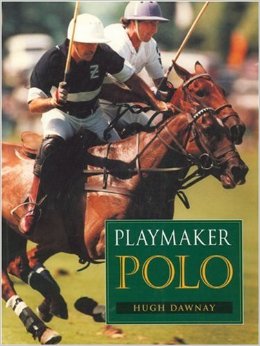
8) RIDING
When stopping look behind you, while squeezing legs, before applying light hands, through reins to pony’s mouth.

10) TACTICAL
During play when a ball is hit past you, and beyond you, and the next shot ( forehand or backhand ) is clearly yours, without being involved in a ‘ride off’, immediately move laterally until you are directly behind the ball to claim the line. This prevents experienced opponents claiming fouls against you, from a …

11) TACTICAL
To hook a stick ‘focus’ on a point 2 inches above the the opponent’s mallet head on the cane. Aim to hit this point with the same spot on your mallet, thereby allowing for 4 inches of error. Repeat ‘focus’ 3 times; first before start of shot; second when swing is extended and third for …

12) STRIKING
For every ‘shot’ you make apply 2 Clocks. First the Pony Clock (PC), with ’12 o’clock’ between pony’s ears and ‘6 o’clock’ over pony’s tail. Second the Ball Clock (BC) striking ‘6 o’clock’ to hit straight,on both sides of pony, ‘4 o’clock’ to hit offside neck shot and ‘2 o’clock’ to hit nearside open backhand, …

13) RIDING / TACTICAL
During play when the ball crosses the backline, at either end of the Polo Field, do NOT STOP until in the correct position for the following ‘hit in’. Then be moving (NOT STATIC) while the player, hitting in, approaches the ball.

14) WITHIN A TEAM
To participate effectively in a team as a playmaker, you must develop three abilities : 1/ To receive and give passes 2/ To compete successfully for the ball in the 25%. 3/ To prevent opponents hitting the ball, from good anticipation, in the 75%.

15) TURNING
In order to playmake, you have to turn before the game does, by going into attack free, unmarked and facing goal to receive passes. Also, you must turn into defence early enough to ride-off or hook the last opponent.

16) INTERCHANGE
At any time in a chukka, you may interchange positions within your team and then, temporarily, you will cease to be the link to the goal, as another player takes over the job. But this means that you must carry out other team duties including marking a different opponent in defence.

17) FOR EVERY SHOT
For every shot, whatever the situation, beware : 1.Not to allow your shoulder rotation to push the right hand above the pony’s tail and out of the perfect circle. 2.That the mallet head does not move back too early and/or drop out of the circle. Naturally, these faults can be easily detected for you by …

18) NUMBER OF CHUKKAS PLAYED
The number of chukkas played by each pony should be planned for the good of the pony more than the benefit of the player. In club chukkas, many people automatically book two chukkas for all their ponies, in pursuit of enjoying the maximum playing time, without realizing that they are indulging in a false economy. …

19) INTERCHANGING POSITIONS
Changing positions with another team member is the most effective way of surprising your opponents, especially if you are playmaking to initiate the next play. Not only can you evade your normal marker, but you will also confuse the other opponents if, undetected, you suddenly get possession of the ball in the new position.

20) DISPARITY OF SKILLS
The significance of the handicap factor in polo, is that the less skilful need courage to go into the field with brilliant players. Hence they desperately require help from a playmaker, while selfish play by others will totally prevent them from participating in a constructive manner. Tactics should therefore be planned to allow all players …

21) UNIQUENESS OF POLO
The three ways in which polo is unique among sports : 1- The disparity of skills of the participating players 2- That there is a right of way related to the path of the ball 3- That, without relation to the ball, you can obstruct another player in the 75%. The combination of these three …

22) USE OF THE SHOULDER
Each circle rotates round the right hand of the striker, who should add support to it by turning the relevant shoulder towards the ball. This assists the eyes to focus on the ball and obviates using arm strength. For the forehands on the offside and the backhands on the nearside, the left shoulder couples with …

23) AVOIDING STRAIGHT BACKHANDS
Hitting straight backhands, on both sides of the pony, are the worst mistakes made by beginners. During a polo game they are universally regarded as bad shots. In the majority of situations they give the ball to an opponent, and they cannot be received as pass by a team member. Also, straight backhands will, too …

24) TWO DIMENSIONS
A good player as to strike the ball makes a precise adjustment to deal with two dimensions. 1. To join the line of the ball as early as possible. 2. To place the pony to the ball accurately, in order to be able to hit through the required circle and aim in the exact direction …

25) LOOK
It is the basis of your polo tactics to look around continually. If it correctly applied, this gives continual « all round vision », which enables you to see everything that happens, the current line of the ball and all that is about to be done by your three team mates and the four opponents. …

26) APPLICATION OF LEGS
The pony and the player should be balanced before a strike is commenced and this is done simply by a strong squeeze of your legs. This action will also greatly assist you to make an accurate approach to the ball.

27) TIMES TO TURN
Far too many polo players consistently turn late. Also, their subconscious rules and misleads them into thinking that the ball will not reach them, until they see it actually arrive. There are four different times to turn but only the first is correct. 1- Before the ball is struck, so that you can become the …

28) HOW TO IMPROVE?
How can you make yourself improve at looking? By being regularly monitored by a coach or anyone who is willing to watch you constructively. Also, before mounting a pony, stretch your neck muscles by looking left and right and behind you several times. Then you should extend this self-discipline to make yourself look around between …

29) LINE COMPLICATIONS
The line of the ball is very simple, in that is the expect path of the ball, but deflections cause complications because then the right of way changes rapidly. The better players also muddle opponents (and sometimes umpires) by appearing from nowhere to claim the line. When in the 25%, there are four possible situations …

30) ADJUST
This is a continual process, which can only be done correctly by first looking. Four players on a full-size polo field are operating on the equivalent length of three football pitches and often an enormous amount of adjustment is required. You should never be satisfied with your position, even when the rest of the team …

31) ECONOMY
A car driver who brakes and accelerates too much will quickly run out of petrol. How big is the tank of a polo pony ? Seven and a half minutes, if the pony is fit and is not over exerted early in a chukka. Unnecessary use of speed can be avoided, and braking minimized, by …

32) DISTANCES
At every time, distances between you and others must be kept as constant as possible to allow you to stay in reach but not too close. Probably the worst mistake in polo lies in this dimension, because players are too often either huddled together or too far apart. Hence control of the field is not …

33) SEAT
Always sit on the front of the saddle and check regularly that you have not slipped backwards to be on the cantle. This is very important because : – It enable you to hit the ball early – You will be secure in the saddle, permanently well balanced, and your body’s centre of gravity will …

34) SPEED
The speed of the ponies has to be varied incessantly to achieve the above and maintain a correct position. High-goal players are very skilful at making minor accelerations and decelerations. control of speed is much more important than pure speed and, again, good riding is a vital factor.

35) FOCUS ON THE MALLET NOT BALL
By pointing the heel of the mallet head upwards, it is easier to make a firm contact on the other mallet as it swings down. Aim at a point on the cane of the opponent’s mallet, two inches from the mallet head the real secret for a novice is to avoid looking at the ball, …

36) DISTANCE BETWEEN PLAYERS
What is the correct distance between players ? The answer depends on the standard of polo. A perfect team when anticipating a pass from their N°4, should adjust positions so that : – a short strike will reach N°3 – an average shot will find N°2 – the best hit will travel to N°1 In …

37) PRE-MATCH PREPARATION
Implement regular pre-match agenda that examines : 1. relative strengths of both teams. 2. Strong and weak points about each player. 3. Order of play for ponies. Inside information about the opponent’s ponies, if obtainable, will assist here, but otherwise it is important not to allow all the players in a team to ride their …

38) HOLDING THE MALLET CORRECTLY
The thumb and index finger take the majority of the weight while the other three fingers assist you to hold the mallet lightly. The thumb is placed in the sling, which supports the back of the hand, and the index finger operates like a pistol finger, in a way which avoids taking a hammer grip. …

39) FROM ATTACK TO DEFENSE
The most dangerous time for N°2 to forget about defense, is when an attack is flying down the field. A sudden burst of acceleration by an opponent, to win a ride-off and hit a surprise backhand, can start an opposing attack instantly. Hence the necessity for N°2 TO WATCH FOR THIS POSSIBILITY AT ALL TIMES, …

40) INITIAL HAND POSITION
The correct early placing of the hand and mallet is essential, and using the appropriate catchphrase should be helpful. This will give maximum scope for applying any swing modification. For the dead ball, when taking a penalty or in a set-piece play, it will be more effective if you start a good distance from the …

41) TEAM
Watching other members of your team is essential, in order that you can frequently commentate to yourself, before the ball changes direction: “Now in attack, now in defence” etc. This will make you easier for you to read the game and adjust laterally, to allow passes of different lenghts to arrive. You can even receive …

42) HANDS SOFTLY APPLIED
Soft, sympathetic hands are easy to apply from a correct seat or half-seat, supported by strong legs. While, in due course, a car can be fitted with new brakes, a new mouth for a pony is unobtainable. By keeping your left hand low, neck-reinning becomes extra effective for all lateral adjustments. The use of strong …

43) PENALTIES AND TACTICS
Penalties can be awarded from the spot, the centre, the sixty-, forty- and thirty-yard lines, or take the form of a penalty goal, followed by a throw-in ten yards from the goal. The umpires decide witch one to award using three criteria : where the foul took place, the direction of the play and the …

44) TURNING INSIDE AN OPPONENT
In a match, during a ride-off, when the direction of the play suddenly changes; how can you turn in the same direction as the opponent, yet not be left behind ? The answer is by turning inside the opponent. To do this, you have to slow down or even stop, waiting with your eyes focused …

45) AVOID HITTING THE PONY
The neck shot is probably the easiest shot to learn on a wooden horse or when going slowly on a pony, but at speed it becomes the most difficult to perform accurately. This is because it has to be struck across the front of the pony’s moving legs and you have to hit very early, …

46) HOOKING STICKS DISTANCE
A hook is necessary when you are in the 25% but it is clear that your relevant opponent has an advantage, in that it is too late for you to win a ride-off and not possible to look for a foul. Hence the priority is to prevent a shot being completed without committing a foul. …

47) THE BACK ROPE
The back rope tactic provides the greatest scope fr a No. 4 to playmake, while changing defense into attack. It is a manœuvre which the opposition finds difficult to control, especially if the whole rope changes direction in a few seconds, and No. 4 is unmarked for at least one shot. This tactic can be …

48) WORKING IN A VERTICAL LINE : KEEPING EQUIDISTANT
If you are a group of four people or less, you should position yourself in a vertical upfield line, equidistant one behind the other, five or six yards apart, or whatever distance is decided by you or your coach. Then, each person takes a turn to be the leader playmaker, doing turns, circles, halts and …

49) FIGURE OF EIGHT
For the purpose of illustrating this exercise, I will use as an example a group of six people. They should form up in a horizontal line, with the appointed playmaker positioned in one of the middle spots. If numbered from the left, No. 6 will be on the far right and No. 3 or No. …

50) CRITIQUE
How do you know if you are adjusting correctly and quickly enough when playing ? By the results you may reply. But it is possible to win playing badly and to lose playing well, and it is important to know that you can only play as well as you are allowed to. An effective coach, …
